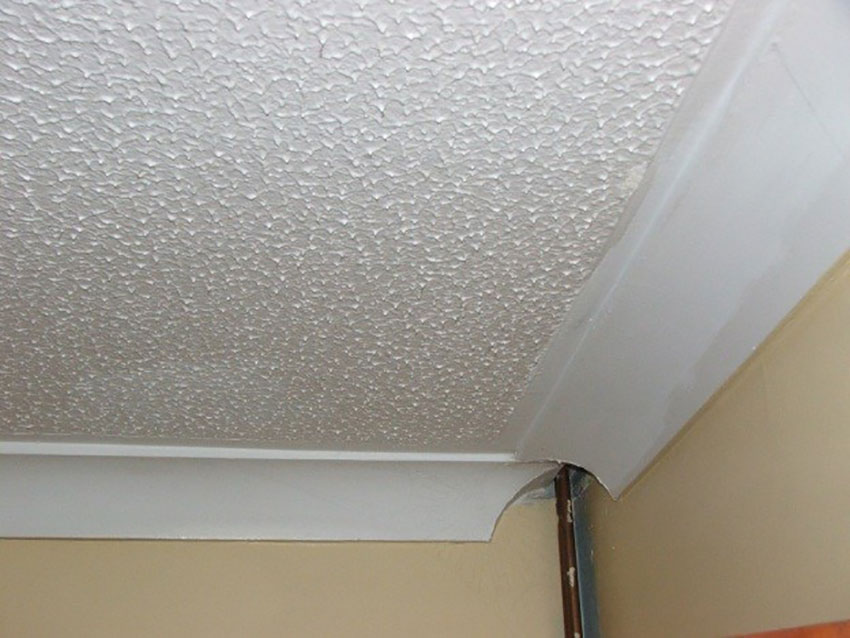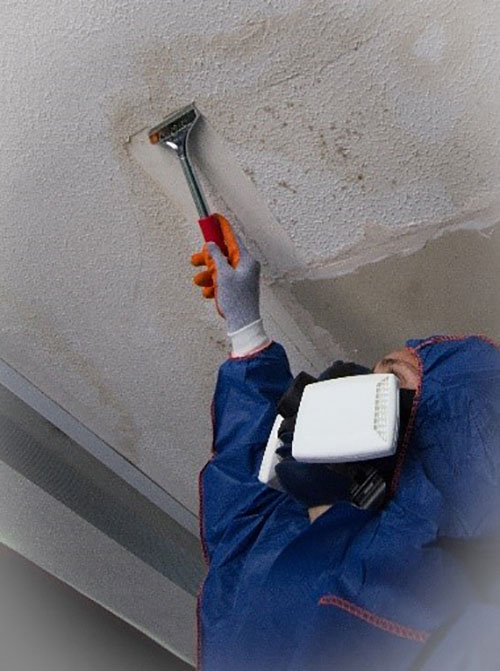Asbestos in Artex Coverings: What You Need to Know
Does Artex contain asbestos?
Yes, some older Artex textured coatings contain white asbestos (chrysotile). The amount is usually small—typically between 1% and 4%—but it varies by product. Not all Artex contains asbestos, so testing is required to be sure.

What is Artex and its History with Asbestos
Artex is a type of textured coating used for interior decorating and design. It was particularly popular in the UK from the 1960s to the 1990s. The name “Artex” originates from the company that produces the coating, Artex Ltd, which has since rebranded as Okarno. Unlike traditional plaster, Artex was promoted as a material intended to receive a textured finish, allowing for various decorative effects on ceilings and walls.
Unfortunately, Artex has become well known for its history of containing asbestos, the hazardous material that was added to the coating in order to promote dewatering and curing of the product and to also provide a reinforcing effect. Chrysotile asbestos, also known as “white” asbestos, was specifically used in Artex.
White asbestos (chrysotile) is the most common type found in Artex textured coatings. While not all Artex contains asbestos, older applications may include small amounts—typically between 1% and 4%. Testing is the only way to confirm its presence.
This type of asbestos was favoured for its strength and heat-resistant properties, making it a common additive in many building materials of the time. However, the presence of chrysotile asbestos in Artex means that any disturbance of the material can release dangerous asbestos fibres into the air, posing significant health risks.
When was asbestos used in Artex and why?
Asbestos-containing Artex was extensively used during the 1960s, ‘70s, ‘80s & 90s when asbestos was unfortunately still legal in the UK.
Although Artex was also offered in a non-asbestos-containing form from 1976, asbestos-containing Artex continued to be produced in the UK until 1984 and was still being installed well into the late 1990’s.
According to the manufacturer, asbestos was added to Artex in order to promote the dewatering and curing of the product, and because of the reinforcing effect that asbestos fibres had on the matrix.
Does all Artex contain asbestos?
The short answer is no; asbestos-free Artex was made available in the 1970s, although it is impossible to ascertain for sure, without appropriate asbestos testing, whether any given Artex does or doesn’t contain asbestos. It is crucial to have artex tested by an accredited consultancy as it is a non-homogenous product so has a unique way of how it is tested that includes multiple sample locations to ensure safety and compliance with health regulations. This is because, even after asbestos-containing Artex was banned in the UK in the 1990s, imported materials may have still contained chrysotile asbestos as late as 1999.
A rule of thumb, if your home was built before 1985, the textured coating is very likely to contain asbestos. If it was constructed between 1985 and 1999, the coating shouldn’t contain any asbestos, but might still do so, especially given that some stockists or tradespeople may have kept asbestos-containing variations in stock well into the late ‘90s.
Meanwhile, if the property was built after the year 2000, there should be no trace of asbestos at all in the Artex coatings.
When was asbestos banned from Artex in the UK?
Although asbestos-containing Artex ceased production in the UK in 1984, it took until 1992 for its use to be formally prohibited by EU and UK legislation. However some usage continued even though it was prohibited. This was mainly due to using up of held stock.
This was followed in 1999 by the complete banning of the manufacture and supply of all asbestos products in the UK.
How to tell if Artex has asbestos
As we have mentioned, you can’t be 100% sure whether any given Artex decorative coating contains asbestos just by looking at it with the naked eye.
It is also important to consider how much asbestos might be present in the Artex, as the levels can vary based on the age and type of the material.
This is because asbestos was always mixed with other non-asbestos materials in the Artex, and the fibres are so small that even if they are released, they cannot be seen and don’t give off an odour.
It’s, therefore, best practice to assume that any textured coating in your property you know was installed prior to 2000, contains asbestos – at least until professional laboratory asbestos testing has been undertaken to determine whether this is the case.
How do you test for asbestos in Artex?
Here at Oracle Solutions, we are proud to be trusted professionals in Artex asbestos testing. By having the decorative coating in your property sampled and tested by our surveyors, you will be able to get a definitive answer as to whether asbestos in Artex is indeed present so that you can plan your DIY or renovation works accordingly.
It is crucial to be asbestos aware during the testing process to ensure that all safety protocols are followed and to mitigate any potential health risks.
Call us today and we will be able to arrange for a qualified asbestos surveyor to arrive at your property to assess what is required.
Samples, for instance, can be obtained by carefully scraping the coating with a screwdriver or narrow scraper, with the material being directed into a sample container held below the sampling point. Due to the non-homogenous nature of textured decorative finishes, various sampling points of the material will need to be taken to ensure a spectrum of the material is sampled. It goes without saying that this sampling process should be carried out by certified asbestos professionals.
If the sample does come back as positive for containing asbestos, then you will need to decide how you wish to proceed with the works.
What are the Risks and Dangers of Asbestos in Artex Ceilings
Asbestos-containing Artex ceilings pose a significant risk to health if disturbed or damaged. When asbestos fibres become airborne and are inhaled into the lungs, they can cause serious health problems, including lung cancer, mesothelioma, and asbestosis. These conditions are severe and often fatal, with symptoms that may not appear until many years after exposure.
The risks associated with asbestos in Artex ceilings are particularly high when the material is sanded, scraped, or drilled, as these actions can release asbestos fibres into the air. Even low levels of exposure can cause these conditions, and there is no safe level of exposure to asbestos. Therefore, it is essential to be aware of the asbestos in Artex risk when undertaking renovation or DIY projects. Proper precautions, such as professional artex asbestos testing and safe handling procedures, are crucial to prevent asbestos exposure and protect your health.
What are the Legal Requirements for Asbestos in Artex
In the UK, asbestos-containing materials (ACMs), including Artex, are regulated by the Health and Safety Executive (HSE). The Control of Asbestos Regulations 2012 requires employers to manage the risks from asbestos in the workplace. This includes identifying and assessing the risks, preparing an asbestos management plan, and providing information and training to employees.
Homeowners are also required to take steps to manage asbestos in their properties. This involves identifying and assessing the risks, and taking measures to prevent disturbance or damage to asbestos-containing materials. The HSE provides comprehensive guidance on their website about working with asbestos-containing materials (ACMs), ensuring that both employers and homeowners are well-informed about their responsibilities and the necessary precautions to take.
By adhering to these legal requirements, you can help to minimise the risks associated with asbestos in Artex, stay compliant and ensure a safe environment for all concerned.
What are my options for dealing with asbestos containing materials in Artex coverings?
Even if it is confirmed that your property’s textured decorative coatings contain asbestos, it’s fine to leave them alone, provided that they are in good condition and undamaged. The fibres are well-bonded, so only disturbance or damage to the Artex increases the risk of asbestos fibres being released into the air, and thereby endangering your health.
For instance, in the event that you wish to simply change the appearance of your wall or ceiling, if the Artex is in good condition and you don’t plan to sand, grind or chip the material beforehand, one solution might be to just plaster over the textured coating.
Indeed, undertaking such work – such as by covering the existing coating with a layer of plasterboard or skimming over it with a new layer of plaster – might make the underlying material safer.
However, it is important to bear in mind that if this route is taken, the asbestos will remain in situ underneath. As a consequence, it will be necessary for any future works – such as drilling – to be performed in a controlled manner to ensure harmful fibres are not released.
Alternatively, depending on the nature of any planned DIY or refurbishment works it may be necessary to conduct a more extensive removal of the textured coatings that contain asbestos. Regardless, our experienced consultants will be able to provide expert advice on the steps you should be taking to safely manage or remove the materials in question.
The situation can differ greatly from one property to the next so if you are in any doubt as to what you should be doing next, we would strongly urge you to contact our asbestos surveying and removal professionals here at Oracle Solutions – not least so that we can give you vital peace of mind.
Proper disposal of asbestos waste is also crucial to ensure that it does not pose a risk to health or the environment.

